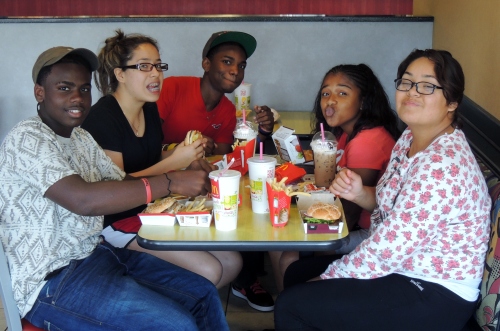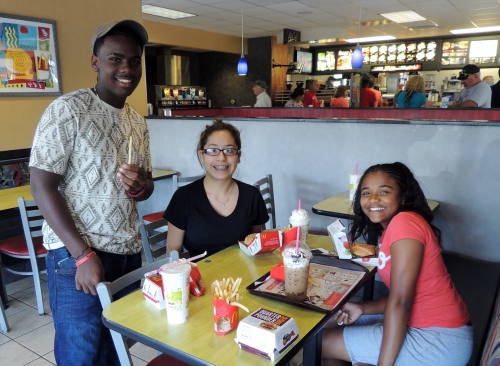Please Sign Petition for a Tax-Free Holiday in Indiana!
Click HERE.
 This weekend – dozens of US states are not charging state income tax on “back to school” needs — but NOT Indiana. Such a simple gesture by lawmakers — is making a significant impact on the budgets of thousands of families — who NEED it. Tax-Free Holidays is one small way to give parents, grandparents, families a little bit of a financial break — at a very stressful time of year for hardworking families who struggle financially.
This weekend – dozens of US states are not charging state income tax on “back to school” needs — but NOT Indiana. Such a simple gesture by lawmakers — is making a significant impact on the budgets of thousands of families — who NEED it. Tax-Free Holidays is one small way to give parents, grandparents, families a little bit of a financial break — at a very stressful time of year for hardworking families who struggle financially.
Education is Important
Since working at Lafayette Urban Ministry — I have learned that most families want the best for their kids, work very hard, and are still struggling. And families who struggle financial — absolutely hate certain times of year. Back-to-School is one of them. Parents want to give their kids the resources it takes to have a better life than they. The key to breaking the cycle of poverty is EDUCATION.
Education is Expensive
But to get the best education you need money — yes, even in the public school systems.
- FIRST kids need the basics — books, pens, trapper keepers, calculators, computers and more. Indiana Public schools charge families $500+ a year per child just for textbooks — and they rarely have enough books for all of the students.
- SECOND, kids want to fit in — so, they need new & stylish clothes, smart phone, the latest athletic shoes, tickets to athletic events, tickets to dances, clothes for dances and more.
- THIRD, extra-curricular involvement costs a lot of money — band, sports, and even student council, debate team, and service clubs require special equipment, uniforms, team photos, snacks, tickets, tournament fees, travel expenses and more.
Research proves that kids get a better education when they have the right supplies, don’t have anxiety about fitting in, aren’t bullied because they are poor, AND are able to participate in athletics, band, music, clubs and organizations, dance, and sporting events. News flash — ALL OF THIS IS EXPENSIVE.
National Retail Federation says on average, parents of kids in grades K through 12 will spend $670 on school supplies this year. That includes clothes, shoes, and electronics. PLUS in Indiana — public school “book rental” fees are typically $400+ per child — and if you have a high school athlete or musician, it’s another $40-100 not including personal equipment, tickets to games, team photos, and snack donations. School is very expensive — even public school.
Boost to the Economy
There is also evidence that it boosts the economy. Families love it, Retailers love it — so, if you’re a state legislator, why wouldn’t you just do it? They are very popular — all you have to do is go shopping in a Tax-Free Holiday State — and you will see excitement in the mall. It’s a great idea. Tax-Free Holidays have been adopted by conservative and liberal state legislatures. This is not a democrat or republican issue — this is a way to support families. This is a way of demonstrating as a public official that you acknowledge families, you support families, you support education and you actually want to have a positive impact.
US States with Tax-Free Holidays for 2015:

- Alabama Tax Free Weekend – August 7-9
- Arkansas Tax Free Weekend – August 1-2
- Connecticut Tax Free Weekend – August 16-22
- Florida Tax Free Weekend – August 7-16
- Georgia Tax Free Weekend – July 31-August 1
- Iowa Tax Free Weekend, August 7-8
- Louisiana Tax Free Weekend, August 7-8
- Maryland Tax Free Weekend, August 9-15
- Massachusetts Tax Free Weekend, August 15-16
- Mississippi Tax Free Weekend, July 31-August 1; September 4-6
- Missouri Tax Free Weekend, August 19-25
- New Mexico Tax Free Weekend, August 7-9
- Ohio Tax Free Weekend, August 7-9
- Oklahoma Tax Free Weekend, August 7-9
- South Carolina Tax Free Weekend, August 7-9
- Tennessee Tax Free Weekend, August 7-9
- Texas Tax Free Weekend, August 7-9
- Virginia Tax Free Weekend, August 7-9
Please sign this petition asking our Governor and state legislature to pass a similar law in Indiana. PLEASE SIGN & SHARE!
THANK YOU.




















































